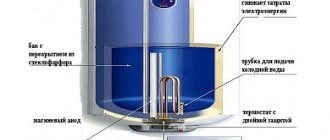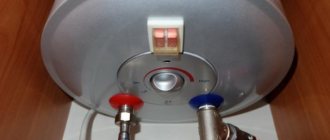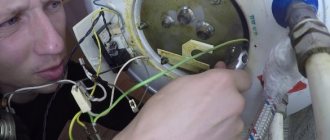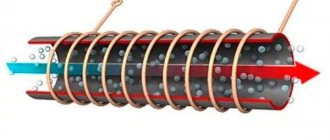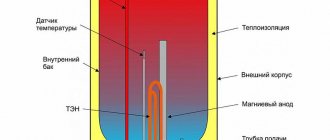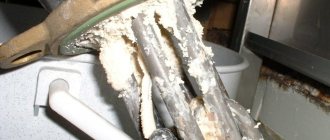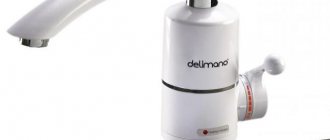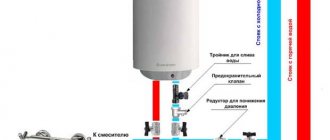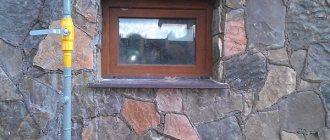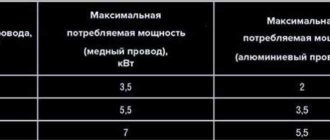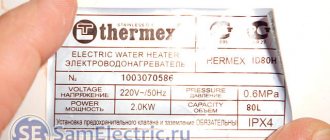Trouble-shooting
It often happens that due to prolonged or improper use, the boiler fails.
Accordingly, the device requires repair. Before calling a specialist, it is worth determining the cause of the problem, because often many problems can be fixed with your own hands. But someone can safely remove the control panel, disassemble the device and fix the problem, while others don’t even know how to replace a digital temperature indicator. Typically, water heater owners face the following problems:
- the appliance has stopped heating water or is not heating it well;
- the tank is leaking;
- water does not flow well into the tank;
- There was a strange sound during operation.
Every summer, utility workers prepare for the next autumn-winter season and temporarily turn off the hot water.
A water heater becomes a real salvation for a city dweller during the period of scheduled work: just turn off the hot water supply valve and turn on the boiler so that hot water will flow from the tap after a couple of hours.
However, any equipment can malfunction, and a water heater is no exception. Often, when trying to start the boiler again, the user encounters an unexpected problem - the electrical appliance does not turn on when the power button(s) are pressed.
There may be several reasons for this problem, and all of them can be eliminated with your own hands without calling a technician.
First, let's clarify what controls can be on the boiler and what functions they perform.
Buttons on the body of the Termex water heater
As a rule, the following buttons and switches are present on the panel of water heaters (Termex, Ariston, Electrolux, etc.) with mechanical control:
- Mode I - turning on the first heating element;
- Mode II - turning on the second heating element;
- Temperature regulator - when you turn the thermostat knob clockwise, the temperature increases to +75 degrees;
- RCD button (residual current device) - is triggered automatically when a current leak appears on the boiler body.
On the panel of modern models of Ariston storage heaters you can also find additional buttons:
- Eco - when you press it, the system for purifying/disinfecting stagnant water starts. If you leave the ECO button on the water heater turned on, after a certain time (1-2 weeks) the disinfection system will automatically start once a month for preventive purposes;
- FAST - button to turn on the fast heating system. By default the boiler operates at the standard power level. Turning on the Fast button on the Ariston water heater starts an additional heating element, which speeds up the water heating process.
Descaling agents for water heaters
The boiler needs to be cleaned approximately every two years. Start the process if you notice the following interruptions:
- the device began to heat the water for too long or switched off frequently;
- the boiler makes a loud hissing sound when operating;
- a yellow liquid with the smell of hydrogen sulfide pours out of it.
If you use the water heater at maximum temperatures, you will have to clean it more often (scale and build-up on the tank form faster). To extend the life of the device, heat the water to 60-70 degrees Celsius.
Another good piece of advice - to reduce the number of breakdowns, do not buy water heaters with heating elements made of ferrous and galvanized metals. Such parts are less resistant to rust and do not cope well with heating water.
Give preference to magnetic thermostats.
Cleaning your water heater is not a very complicated process and can be done on your own. After all the water has been drained, disassemble and remove the heating element. To do this, remove the decorative cover (most often it is secured with screws). In some boiler models, the parts we need are covered with a plastic panel. It is held on by clamps - just pry the bar off with a screwdriver.
Take a photo of the connection diagram so that you can return everything back after the procedure. Disconnect the wires to expose the thermostat. Get him out.
Scale is the number one enemy of boilers. If you do not periodically clean the heating element, it may become irreversibly damaged. Timely cleaning of the heating element will save you from wasting money and will significantly extend the life of the device. Carefully remove the heating element. Next to it you will see an annon that protects the insides of the tank from corrosion. See if it's intact. If not, replace the part with a new one.
Preparing the water heater for cleaning. Before you prepare your water heater for cleaning at home, you need to find out what contributes to the formation of scale and how to understand when it’s time to clean the unit. So, the following signs will indicate to you that the boiler is dirty:
- frequent use of the unit will lead to scale formation;
- the water in the boiler takes a long time to heat up, as a result of which more electricity is consumed;
- the water tank overheats;
- the liquid has acquired a yellowish tint;
- The water heater is noisy.
If all this happens to your boiler, then scale, rust or other contaminants have probably formed on the walls of the tank, inside the tank and other parts of the water heater.
The frequency of cleaning depends on several factors:
- if the operation of the water heater is frequent;
- if the hardness level of the water you use is too high: for this reason, scale accumulates faster. In this case, the water heater should be cleaned once every six months to 9 months. If the level of hardness is not high, the water is soft enough, then an acceptable frequency of cleaning would be once every 2-3 years;
- if the boiler operates, regularly heating water to 60 degrees: this temperature regime promotes the spread of germs and bacteria. To avoid the proliferation of harmful flora, once or twice a month you need to set a temperature that is higher than the one consistently used - raise it to 80-90 degrees, holding it for one or two hours.
There are two ways to clean a water heater: chemical and mechanical. Let's start with the first one.
This method does not require special dismantling of the boiler. A descaling agent can be purchased at a store specialized in household chemicals or a special department of a supermarket, or you can use traditional methods by preparing a solution at home. If you use citric acid as a cleaner, dissolve 50 grams of powder for each liter of water (this is 1 package).
Everything you need is at hand, so you can get started.
- The first step is to get rid of a third of the water in the boiler tank. This must be done through the tap where hot water comes from.
- Next, you need to turn off the cold water so that liquid does not enter the water heater tank.
- Attach the hose to the drain fitting and begin pouring a pre-prepared solution of citric acid or vinegar through it.
- Now you should open the cold water supply, setting the heating temperature to 90-95 degrees.
- Let the cleaning agent sit in the tank for about 5-7 hours.
- After the time has passed, drain the water, add new water, and also drain it so that the walls of the tank are thoroughly washed.
To clean the boiler mechanically, you will need gloves, sandpaper, a screwdriver, a wrench, cleaner and a screwdriver.
- First of all, you need to disconnect the boiler from the water supply by shutting off the water supply.
- After the supply is turned off, unscrew the pipe from the hole through which hot water flows, attach the hose, placing its edge in the bathroom or sink.
- Next, unscrew the cold water pipe and drain the remainder.
- Proceed to the panel, power terminals. As soon as you disconnect these parts, unscrew the electrical wire.
- Unscrew the bolts holding the cover, which covers the contacts and fastenings of the heating element. To avoid problems when connecting, it is better to take a photo of the original position. Carefully remove the thermostat from the tank.
We will tell you how to clean the heating element itself from scale a little later, but for now we will focus on how to remove dirt from the walls of the water heater tank. Most often, scale concentrates on the heating element, but if you already see it inside the tank, you can clean it as follows: place the container and turn on the water - the remaining dirt should be washed away.
In case of severe contamination, such that a thick layer of plaque has appeared on the walls of the tank, the scale should be removed manually. It is not recommended to clean the enamel surface from contamination using abrasives. It is better to use a solution of acetic acid, preparing it in the ratio: one package per liter of water. Fill the tank with the solution overnight and then rinse with clean water.
Cleaning the heating element
Sometimes cleaning water heaters for various reasons requires a lot of labor, as is the case with indirect heating boilers. It is not so easy to remove the copper heat exchanger from it. And with conventional large-capacity heaters you won’t have any worries. In such situations, you can clean it without disassembling or removing the device using chemical agents to remove plaque and dirt.
Interruptions in the operation of the water heater begin 2–3 years after the start of its operation. The heating element located in the storage boiler is covered with a layer of lime, increasing in thickness day by day.
The following signs also indicate the need for cleaning:
- heating time and, accordingly, electricity consumption increased;
- the device produces uncharacteristic extraneous sounds, most often hissing of varying volumes;
- the water has acquired a yellowish tint;
- the water emits a characteristic hydrogen sulfide odor;
- yellowish flakes are visible in the water - pieces of scale;
- the outer walls of the tank began to overheat.
If the water in the apartment has a hardness of more than 350 mg/l, it is recommended to clean the heater annually. In some areas, the water is so hard that scale accumulates on the heating element within 5-6 months, and it needs to be cleaned.
Buy electronics for water heaters
Many users sooner or later experience breakdowns or wear and tear of their household appliances. And the question immediately arises: “Where to buy electronics for water heaters in St. Petersburg?” It is best to contact specialists, because we can talk about such components as:
- Power unit (provides voltage supply).
- Control module.
- Display.
- Thermostat.
- Residual current device.
An important advantage of good specialized stores is an extensive catalog of electronics for water heaters. A large number of different positions allows you to correctly and quickly select the spare part you need.
Experienced employees will help you decide on a purchase, offer an alternative option, or select a universal model.
High-quality water heater electronics, the price of which is acceptable to the consumer, can always be found at Ter-Market. Call us and we will solve your problem!
When the question arises about choosing a water heating system, many choose appliances. It has established itself as a manufacturer of reliable, safe devices that are easy to install and operate. Any Polaris water heater provides fast heating and good pressure.
Both flow-through models and Polaris storage boilers are equipped with a reliable heating element. It is in a protective flask and does not come into contact with water. This helps prevent its corrosion. Storage devices are economical; they do not operate constantly, but turn on automatically to maintain the set temperature.
Different models may have electronic or mechanical controls, but all have a display that allows you to monitor water temperature and other parameters. It is possible to adjust the power level.
Additional Information!
The inner walls of the tank are made of stainless steel, and the magnesium anode prevents corrosion. The outer walls have high-quality thermal insulation, which increases its performance and safety.
Most models are wall mounted. They are compact and can have a vertical or horizontal orientation. The design is made in a minimalist style: white body, display and control knobs. The water supply is mainly from the bottom. Flow-through models are equipped with a shower head.
Features of gas connections
When connecting gas stoves, water heaters and other types of equipment, flexible hoses are also used. Unlike water models, they are yellow and are not tested for environmental safety. For fixation, end steel or aluminum reinforcement is used. There are the following types of devices for connecting gas appliances:
- PVC hoses reinforced with polyester thread;
- made of synthetic rubber with stainless steel braid;
- bellows, made in the form of a corrugated stainless steel tube.
The Santekhkomplekt holding offers engineering equipment, fittings, plumbing fixtures and devices for connecting them to communications. The assortment is represented by products and materials from well-known foreign and domestic manufacturers. Discounts apply for bulk purchases, and product quality is confirmed by standard certificates. For information support and assistance, each client is assigned a personal manager. The ability to arrange delivery within Moscow and to other regions of the Russian Federation allows you to quickly receive the purchased goods without unnecessary hassle.
Installation and connection
Installed device
Modern boiler-type water heaters are mounted vertically. Most buyers prefer this type of structure, as their installation is much faster and easier. Installation using the “open” method is carried out in stages:
- Make sure the location you choose is near an outlet.
- For fastening, use special brackets, often included with the equipment.
- If an optional mount is purchased, make sure it is rated for the weight of the filled tank and will support the suspended structure.
- The instructions for the boiler contain information regarding technical requirements; adhere to the manufacturer’s recommendations.
- Place the drain hole at the bottom.
- Install the safety valve.
- Purchase an additional fuse (valve) in advance; make sure that the hole is always open.
- After installing the fuse, connect the pipes and compression hoses to the sewer system.
- Treat the joints with plumbing sealant.
- Weld the boiler pipes to the general water supply.
- Supply cold water through the ball valve.
- Connect the heater to the power source and check operation.
Popular breakdowns and their repairs
According to customer experience, the most common malfunctions that lead to undesirable consequences and require immediate attention are:
- scale formation on the heating element, which leads to insufficient heating of water or its complete absence;
- thermostat malfunction;
- contamination of the boiler cavity, as a result of which the quality of the water deteriorates, rust impurities and odor appear;
- control board failure, cable damage: leads to the fact that the device simply does not turn on;
- lack of indicator light signal - this happens due to a burnt-out LED or faulty electrical wiring;
- There is a leak in the housing or structural connections.
To ensure uninterrupted operation of the heater, diagnostics should be carried out periodically. Also replace the magnesium anode at least once every 2 years. It is recommended to clean the heating element from contamination once every 3 years. If the quality of tap water is poor, such procedures are carried out much more often: once every 1-2 years.
Answers to frequently asked questions about Termex water heater buttons
All storage water heaters (boilers) operate on the same principle and have a similar design.
This is what the electrical circuit of the most common Termex electric water heater with mechanical control looks like:
As can be seen from the diagram, there is nothing complicated in the design of the device.
- The operation of two heating elements is regulated through a simple control panel, which has heating control and monitoring devices.
- Thermostats installed inside the flask allow you to smoothly regulate the temperature in the range from +7 to +75 degrees.
- When the water in the storage tank cools down, the heating elements come back into operation.
What to do if the Thermex water heater does not turn on?
First you need to determine the cause of the problem. As practice shows, there may be several of them.
Here are the most common:
- The socket is faulty, there is no voltage in the 220 V network. To check this, just connect any other working electrical device to the socket;
- The integrity of the power wires is broken, there is no contact at the terminals of the heating element;
- The on/off button itself is faulty. In this case, replacing the ON/OFF buttons on the water heater
; - The thermal protection button of the water heater
was activated , opening the electrical circuit. Thermal protection allows you to prevent overheating of water if for some reason the thermostat does not work. To start the boiler, you need to press the hidden thermal protection button. It is located directly on the thermostat block; - The residual current device (RCD) has tripped. If the RCD is triggered once, you can reset the emergency shutdown button of the water heater by pressing the red switch located on the device itself. If a repeated shutdown occurs, this indicates the presence of serious defects and the need to repair the electrical appliance.
You can check the performance of the heating elements using a tester (measuring resistance). A damaged heating element cannot be repaired, but you can always purchase a new heating element and replace it.
VIDEO REVIEW
Draining water from the storage tank
Diagram of the heating element device.
Using a shut-off valve, the cold water supply to the apartment is shut off. If a local valve is provided for the boiler, which shuts off only the necessary part of the apartment water supply, it should be used.
The hot water intake valve on the boiler and the cold water supply check valve are closed.
Using an adjustable wrench, the cold water supply hose to the water heater is disconnected, but the hot water extraction hose is not disconnected.
A rubber hose is placed on the boiler check valve. The second end of the rubber hose is directed into the sink, jacuzzi, bathtub. Water from the boiler will drain through it.
The boiler check valve and the hot water intake valve open. All hot water taps connected to the water heater are fully opened: in the bathroom, in the kitchen.
Atmospheric pressure is generated in the boiler storage tank, and water is pushed out through a check valve. Typically, water is discharged from the boiler in several portions as the pressure in the tank increases.
You can check that all the water has been drained by blowing into the rubber hose on the check valve. If water remains in the tank, a characteristic gurgling sound will be heard.
It may happen that the pressure in the water supply system is not enough to displace all the water from the boiler. In this case, the hot water extraction hose is removed and additional pressure is pumped into the tank through the hot water extraction tube using a compressor.
Attention! The cold water supply pipe to the storage tank rises above the level of the bottom wall. Therefore, a small part of the water will remain in the boiler and will drain only through the mounting hole of the heating element panel. This factor must be taken into account when further disassembling the water heater.
How to drain water from a water heater
Before disassembling the water heater, it is necessary to drain the storage tank - drain the remaining water in the water heater. Typically, two pipes are connected to the device:
- liquid withdrawal system;
- system for collecting liquid from a water supply system.
Drying can be done in several ways.
Standard method
This method is given in the operating instructions for the device. You will need to use a tee, which is located next to the valve and pipes of the system. Drying is carried out by shutting off the water supply pipe. The remainder of the already stored liquid is drained through the mixer.
The described method is relevant for models of the previous generation; modern devices are most often not equipped with a tee.
Using a lever (trigger)
A device located on the safety valve will help quickly get rid of accumulated water. All you have to do is simply bend the lever and the boiler will drain. It is worth noting that the procedure performed using a trigger can take a long time. Connecting a hose will help speed up the process significantly. By attaching it to the spout, you will greatly facilitate the outflow of water, but the water will still drain within two hours.
Alternative method
If none of the listed devices are installed on the device, you will have to resort to a more complex method. To do this, you need to unscrew the check valve counterclockwise. The pressure of the drained water will be very strong, no need to panic because of this, prepare a suitable container and clothes that you don’t mind getting wet. To protect the room from water, experts recommend using a durable hose, the length of which will be sufficient to connect it to the drain of the bathtub or toilet.
We recommend: Architectural elements of the building facade in pictures: photos and videos
If water does not flow after unscrewing the valve, this means that the hot water supply is cut off. At the same time, the flow of air is blocked, without which draining is impossible. Only after completing this procedure can you begin to further disassemble the boiler.
Your job is to use it correctly
Having purchased Ariston electrical equipment for your home, do not forget to carefully study the instructions and always have it “at hand”. Following the instructions should in no way be skeptical or underestimated, as it is primarily for your safety. Even if you accidentally lost the instructions for the device, you can get its electronic version specifically for your Ariston model on the official website of the manufacturer
People who create electrical devices check them, test them, put maximum useful information into application and operation manuals with the only important goal - so that you use them correctly. This article will also discuss general requirements and initial information.
Ariston 50 boiler diagram
Boiler designs have approximately the same construction scheme. It contains a housing, a water container (the boiler itself), and a heating element (otherwise known as a heating element, sometimes several of them are included in the package). A magnesium anode must be installed next to the heating element, which prevents the formation of scale. The boiler itself has a heat-insulating layer on both the outer and inner parts.
Two pipes lead to the water heater - one for supplying hot water, the second for cold. Boiler bodies can be cylindrical or flat. The boiler tank can have different capacities - from 30 to 100 liters. The basic principle of operation of a boiler is to heat water in a tank and maintain its constant temperature, set by a person depending on the need.
How to disassemble a flat tank water heater
Action plan:
- the boiler is disconnected from the power supply, the water is drained and the check valve is unscrewed;
- unscrew the plug nut;
- plastic shields are dismantled;
- in the center of the plastic cover, a screw is unscrewed, which is most often sealed with a sticker;
- the bottom cover is removed and access to the complex circuit of electrical components is opened (before disassembling it, it is advisable to photograph the structure, sketch and label each component, this will then help to assemble everything correctly and quickly);
- The next step in disassembling a water heater with a flat tank will be to disconnect the control board and thermal protection, for which you unscrew all the screws and nuts of the grounding bracket (you should remember that the thermal protection and electronic board are afraid of water, so it is very important to protect them from its influence);
- disconnect the connector that comes from the outer board from the electronic control board;
- to dismantle the heating element, which is attached to the flange, you should unscrew the nuts (the work can be complicated if the heating element is covered with scale; remove it slowly, with extreme caution).
Sometimes it is necessary to dismantle both the internal and external control board, which is located on the outside of the water heater body. Before removing it, remove the plastic sticker from the front panel and unscrew the bar.
It's simple. Anyone can do this kind of work with their own hands, without the help of specialists.
The best posts
- Balloons in the decor of a children's room for the joy of kids
- Templates for paper applications for 1st grade children: butterflies and a vase
- Quilling butterfly: master class for beginners with photos and videos
- How to level a wall for tiles: preparation and leveling, installation and whether it is necessary to plaster the surface in the kitchen
- Interior trends - summer 2019
- Carbon heated floor: infrared rod mat, electric carbon under laminate and reviews
- IKEA living rooms - 100 photos of the best models from the 2019 catalog
- How to decorate the steps of a staircase in a house or country house (33 photos)
Related article: Screen partition at IKEA: the beauty is in impermanence
Types of Polaris water heaters
produces many models that differ in type of heating, volume, control method, and the presence of additional functions. All of them are divided into two large groups: storage and flow.
Flow-through
This type of Polaris water heaters is compact in size. They do not take up much space and are placed on the wall of the bathroom or kitchen. The principle of their operation is that cold water flows through a housing in which a circular heating element is installed. When it comes into contact with it, it heats up and comes out already hot. The degree of heating depends on the power of the device and pressure. In many models you can set a specific temperature - up to 600.
Note! The operation of instantaneous water heaters depends on water pressure. If it is weak, the device will not turn on
Cumulative
The polaris storage water heater is convenient because it provides a supply of hot water. It is collected in a tank, where special heating elements heat it. Moreover, many models have a temperature support function. This provides energy savings when the device heats the water once and then turns on when it cools down. Such devices are available in different sizes.
Thanks to the environmentally friendly internal coating, the water in the tank remains clean and fresh even for a long time. They do not form corrosion or rust. Many models have a filter for incoming water.
Additional Information! Storage water heaters can provide hot water to several water intake points. They do not depend on pressure, so you can install them in your dacha.
10 liters
If hot water is needed for washing dishes or hands, then a tank with a volume of 10-15 liters will be sufficient. It heats up very quickly and maintains its temperature for a long time.
30 liters
This tank volume is suitable for a summer residence. It provides hot water for washing hands, dishes, and cleaning. It is even enough for one person to take a shower.
50 liters
On average, a 50 liter tank is enough to provide hot water to a family of 2 people. It will allow you to shower regularly and use hot water throughout the day.
80 liters
For the needs of an ordinary family of 3-4 people, an 80 liter tank is suitable. The advantages of such a water heater include the fact that it quickly heats the water; you can select a temperature of up to 750. Then it cools down very slowly, allowing you to take a shower or even a bath.
100 liters
To meet the needs of a large family, you will need a 100 liter storage water heater.
You can connect several water intake points to it. This allows you to use hot water in the kitchen and bathroom.
Tools for disassembling and assembling water heaters
To disassemble the device, you will need a small number of tools; in most cases, every person has them at home, so no additional costs will be required.
Before you start disassembling the water heater, you need to prepare all the tools in advance and lay them out in front of you, so that if something happens you won’t be distracted by searching for a particular screwdriver.
List of required tools:
- Indicator screwdriver.
- Phillips and flat-head screwdrivers (depending on the screws with which the parts are fastened).
- Adjustable wrench.
- Set of spanners.
- Knife and scissors.
- Tow.
- Microfiber cloth to wipe down the insides and parts.
Advantages and disadvantages of Polaris storage water heaters
known in Europe, Russia, the USA, the products are also sold in Asian countries, which would be impossible given their poor quality. Heaters have a number of advantages:
-
used for all water supply systems, including autonomous ones with low pressure;
- work in automatic mode;
- it is allowed to connect the heater through a socket (if there is wiring with a cross-section of 3 mm or more);
- low cost, accessible to people of any income;
- convenient adjustment;
- high safety during operation;
- modern design allows you to install boilers, regardless of interior styles;
- 10 liter models available.
List and characteristics of popular models
The manufacturer offers several lines of storage electric heaters, among which the Vega, Gamma, Omega, PM, FD, Ultra, Mercury and Aqua series are in high demand. Each product line combines several model options that differ in a number of technical characteristics.
| Series/model | Power, W (max) | Capacity volume options, l | Dimensions, W*H*D, mm | Pressure indicator (max, bar) |
| Aqua IMF V | 2500 | 30/50/80/100 | 450*985*310 | 7 |
| Gamma IMF V | 2000 | 30/50/80/100 | 550*885*370 | 6 |
| PM V | 1500 | 30/50/80/100 | 385*710*385 | 8 |
| Mercury IDF V | 2500 | 30/50/80/100 | 450*985*310 | 7 |
| Ultra IMF V | 2500 | 30/50/80/100 | 380*898*270 | 7 |
| Stream IDF V/H | 2500 | 30/50/80/100 | 380*898*270 | 6 |
| Vega IMF | 2500 | 30/50/80 | 809*450*248 | 7 |
All Polaris water heaters are equipped with a remote thermostat. A magnesium anode is built inside the devices, which helps protect the surfaces of structures from corrosive formations. The models presented in the table are positioned vertically during installation.
Since developers constantly introduce the latest technologies into production and use the innovations of technical progress, each of the lines is regularly updated: some models are not produced, moving into the “archive,” and improved versions with expanded functionality are added.
Device differences
PM series design
Electric heaters differ in several qualitative and technical characteristics, for example:
- according to body material: stainless steel or fine glass enamel;
- shape: round, flat, convex, rectangular;
- power: from 1500 to 5500 W (flow devices);
- capacity volume: minimum = 50 l, maximum = 100 l;
- number of modes, additional functions: 1 or 3 modes, “fast heating”;
- location method: horizontally or vertically;
- possibility of electronic control.
Thus, the tanks of most models are made of stainless steel, but the PM series heaters are an exception. For their production, the latest development is used - Italian glass enamel "Colorobbia" of fine spraying. Also, compared to its improved “brothers”, the PM line is distinguished by lower power (up to 2000 W), the absence of an electronic control unit, accelerated heating functions, and there is only one capacity option. The devices are suitable for servicing small country houses, utility rooms, and office premises.
Advantages and disadvantages
Any device has its advantages and disadvantages based on the characteristics, functionality and visual appeal of the product. In addition, when forming the positive and negative aspects of the boiler, reviews of real customers or industry experts are always taken into account.
Oasis water heaters have a number of advantages, including several.
- Quality of indoor and outdoor units. The outer one is made of high-quality steel, and the inner one is equipped with a special enamel coating that provides resistance to temperature changes and also prevents the occurrence of microcracks.
- High level of thermal insulation. The presence of a special layer of polyurethane foam located between the external and internal blocks significantly reduces heat loss in the room.
- Copper heating element, characterized by excellent operating efficiency, which ensures rapid heating of water to the required temperature.
- The presence of a special safety valve, usually hydraulic.
- The presence of a magnesium anode, which minimizes the formation and development of corrosion processes.
- Economical. The boiler heats the cold water that enters it, and then simply heats it up from time to time to maintain the desired temperature and turns off again.
- Easy to use. Most models have a fairly simple heating device control system.
- Safety. For boilers of this brand, all cables are reliably protected.
- The tank model provides only one welding seam, which minimizes boiler leakage areas.
- Special safety sensors ensure uninterrupted operation of the storage heater.
- Long operational period.
In addition, the manufacturer provides a 60-month warranty on water heaters, which only confirms the high quality and reliability of the household appliance.
If we talk about the disadvantages, then these are:
- dimensions - as a rule, water heaters with medium and large volumes have large dimensions;
- duration of water heating - on average, it takes 4 hours to heat 100 liters of water to 70 degrees;
- scale formation on wet heating elements.
If we compare all the pros and cons of the water heater, it is obvious that the device is high-quality and reliable.
How to choose the right boiler?
Before you begin cleaning, the boiler must be emptied of water. The easiest way to do this is if the device is located above the bathtub or if you can place a large container under it. It’s good that when the heating element is screwed directly into the tank, it can be pulled out at the same time as the liquid is drained. In some models, to remove the element, you have to unscrew numerous nuts, then the boiler is emptied in advance.
The water draining algorithm always looks like this:
- Disconnect the device from the network and turn off the water supply tap (on the pipe).
- We turn off the tap responsible for the supply of cold water, located near the heater. After this, turn on the water at the nearest faucet until the glass is hot.
- We attach a tube to the drain fitting, direct it to the sewer, and drain the water by opening the tap.
In the absence of taps and fittings, all liquid can be drained through the safety valve. The main thing is to act carefully and consistently so as not to get burned and not provoke an accident.
You should choose a boiler based on indicators such as:
- type of device;
- tank capacity (in liters);
- heating element type;
- product power;
- material from which the body is made;
- how much does the unit cost?
We invite you to familiarize yourself with a Washing machine with a pump for pumping water.
Equal importance should be given to how much the manufacturer asks for his product. However, the fact remains: the price does not always justify the quality. Therefore, before purchasing, it would be a good idea to “browse” through various forums, where people who have bought this or that model of water heater talk about its positive or negative aspects.
Thus, the relatively inexpensive models “Atlantic” and “Oasis”, the price of which starts from 4,500 rubles, have proven themselves well.
Thus, cleaning a water heater at home is not a complicated procedure. Another thing is that it must be timely. Then the device will not only work smoothly, but will also last for a long time.
How to clean a water heater? It would seem that only plumbing experts know the answer to this question, and only they are able to cope with boiler contamination. In fact, you can clean a water heater from scale and rust at home, you just need to find a suitable material, get acquainted with it and implement our recommendations.
Electric or gas, storage or instantaneous - the type of water heater does not matter, just like the brand - be it Ariston, Oasis, Termex, Electrolux or Polaris. All boilers need cleaning. We hope that our article, as well as the video below, will serve as this auxiliary material.
Features of electric water heaters
Water heater AquaVerso
Under the Aquaverso brand, the market offers boilers of various volumes and technical parameters, fully adapted to domestic conditions. All of them have a standard configuration, cylindrical or rectangular shape. The devices operate on a cumulative principle.
The design consists of a reservoir placed in an outer, decorative shell. Between the walls there is thermal insulation made of polyurethane foam to keep the contents warm longer. Water from the plumbing system enters the tank under pressure and is heated by the heating element to the set temperature. Heating occurs gradually, which reduces energy costs. The temperature is maintained in automatic mode.
The thermostat controls the switching on and off of the device. For clarity, a power indicator is installed. If the red light is on, it means heating is in progress. After the process is completed, it will go out and the water can be used.
Water heaters are produced with the following tank capacity and dimensions (HxDxW):
- 30 l – 54.6x30x45 cm;
- 50 l – 86x25.5x45.5 cm;
- 80 l – 45.9x44.5x76.8 cm;
- 100 l – 121x29x54.5 cm.
All devices, regardless of volume, have a 1.5 kW heating element installed, which affects the heating duration. So, a tank with a capacity of 30 liters will reach a temperature of +50 degrees in an hour and a half, and for large volumes it will take 3-4 hours.
General characteristics:
- power supply from household power supply 220 V;
- convenient water heating regulator;
- wall installation;
- vertical arrangement;
- maximum heating up to 75 degrees;
- bottom pipe supply for easy installation;
- possibility of connecting several consumers.
For production, stainless steel is used with a varnish coating to protect against corrosion and high temperatures. The internal coating of the storage tank walls is also made of stainless steel. The wall thickness of the internal tank is 2 mm.
A distinctive feature concerns 80 l devices. They can be vertical or horizontal. The internal coating of these models is made of bioglass porcelain.
Features of various designs
Before you start repairing a water heater with your own hands, you need to figure out what type of device it is. There are several varieties:
- electric boilers;
- flow-through;
- indirect heating systems;
- geysers.
The word "boiler" means "boiler". It follows from this that such products include not only storage devices, but also flow-through devices.
Electric heaters
This type of boiler is considered the most popular. The design consists of a tank, a thermal insulation layer (polyurethane foam is often used), and an upper casing.
The heating element is located at the bottom of the device. The water is heated to a certain temperature, which is pre-set on the thermostat, the maximum value is +75°C.
If no water is drawn, the device maintains temperature readings by turning the heating element on and off. It is equipped with overheating protection, so when the maximum performance is reached, the device turns off.
The optimal temperature value is +55°C; it is in this operating mode that the structure will last longer and save electricity.
This device is the most common
Hot water is drawn through a tube located at the top of the device. The cold liquid inlet is located at the bottom of the device. The metal tank is protected from corrosion by a special magnesium anode, which has a certain working life. The element must be replaced once or twice a year, depending on the hardness of the water.
Indirect heating systems
Such products do not independently generate thermal energy; water is heated using a coil in which the coolant is located.
Cold water comes from the bottom of the device, hot water comes out from the top. Indirect heating devices can provide large quantities of hot water, which is why they are often installed in large houses. The operating principle is to exchange heat between liquids at different temperatures. In order for the output to be +55°C, heating is carried out to +80°C.
The process takes a lot of time, this feature must be taken into account when choosing a suitable device. Like their electrical counterparts, indirect ones are equipped with a magnesium anode. The structures can be wall-mounted or floor-mounted; in addition, they can be connected to a double-circuit gas boiler. More expensive models are equipped with additional electric heating elements, which reduce heating time as needed.
Gas and flow structures
Gas-powered appliances are only wall-mounted. There is a thermal insulation layer inside the structure. There is a chimney pipe at the top, and a gas burner at the bottom. The latter is a source of heating, in addition, it is helped by the heat circulation of combustion products. An automatic electronic system monitors and extinguishes the gas as needed. The column is equipped with a protective anode.
Gas water heaters produce large amounts of hot water in a short period of time.
Flow systems do not accumulate liquid inside. The heating process occurs at the moment the tap is opened, when the devices allow water to flow through them. The structures operate on both gas and electricity. Gas products are modern modifications of popular geysers.
Electrical systems carry out heating using heating elements of increased productivity. Despite their small dimensions, the products are high-power, so their scope of use is limited. Hot water flows regularly without interruption for heating.
We recommend: Peat briquettes, use of peat for heating rooms, its types, advantages and disadvantages
Gas water heaters have greater efficiency
Trouble-shooting
It often happens that due to prolonged or improper use, the boiler fails. Accordingly, the device requires repair. Before calling a specialist, it is worth determining the cause of the problem, because often many problems can be fixed with your own hands. But someone can safely remove the control panel, disassemble the device and fix the problem, while others don’t even know how to replace a digital temperature indicator.
Typically, water heater owners face the following problems:
- the appliance has stopped heating water or is not heating it well;
- the tank is leaking;
- water does not flow well into the tank;
- There was a strange sound during operation.
If a tank leak is detected, no spare parts will need to be replaced. Here you will need to solder the seams through which water leaks. If there is a leak on the flanges, then you will need to urgently change the gaskets.
If during operation the device produces dirty water and makes strange sounds, then most likely it needs cleaning. First you need to turn off the power to the device, turn off the water supply and remove the lid from the bottom of the tank. They usually come off quite easily. Then you need to disassemble the device. Namely, disconnect the wires and remove the heating element. It can be easily cleaned mechanically or using chemicals. Next, you need to clean the tank itself and thoroughly dry all the parts. Then everything is installed back. Don't forget to turn on the device to check the quality of the work done.
For an overview and installation of the Polaris IDF 50 water heater, see the following video.
Preparing the water heater for cleaning
Assembly must be done in reverse order to achieve functionality; if your device loses functionality, it means you assembled it incorrectly. Examine the rubber part; there should be no cracks, deposits or other damage on it; if there is any, it must be replaced.
We invite you to familiarize yourself with Paint for polyester jackets
Fill the tank by first opening the hot water tap and then the cold one. After the boiler is filled, check its tightness to see if there is any water leakage somewhere. If everything is normal, finish the assembly - connect the thermostat, connect the panel, screw in the cover. The cleaning procedure is completed, you can turn on the electrical power. The boiler is ready for use.
Before you begin assembling the device, inspect the rubber seal. Its integrity must not be compromised. That is, there cannot be scratches, breaks, gouges, or plaque on it.
You need to reassemble in the reverse order from how you disassembled the device. It is better to coat all rubber parts with sealant, this will protect the device from leaking.
After installing the heating element, return the boiler to its original place. Open the hot water drain tap and turn on the cold water. When the boiler is full, check the seal.
The next step is to install the thermostat and connect the wires. A photograph taken earlier will help you. The procedure will be similar if you need to clean an indirect heating boiler.
Cleaning the heating element
Kinds
Polaris water heaters come in different types and sizes. There is a instantaneous water heater, and there is a storage one. The volume of tanks also varies. It can be 10, 30, 50, 80, 100 liters and even 150.
Storage water heaters from this company are available in volumes from 10 to 150 liters.
As a rule, such models can withstand pressure up to eight atmospheres. The design of such devices also has its own distinctive features. For example, storage models can be easily connected to a regular outlet, which is very practical.
As for the time it takes to heat up, it all depends on the model and volume of the tank. Typically, the first heating after installing the water heater takes at least half an hour. Afterwards, the heating element will turn on when the water temperature drops. This way, there will always be hot water in your home's tap. This heating method also helps save energy.
In addition, storage tanks are equipped with high-quality heating elements and have excellent thermal insulation, thanks to which they heat water as quickly as possible and keep it hot for a long time.
When choosing a storage model, it is worth considering the fact that you need a separate place for its installation.
If you only need a water heater for washing or washing dishes, then a tank with a volume of 10-15 liters is the best option. For regular showering, the volume should be at least 30 liters, on average 50. And for those who are used to taking baths frequently, it is worth purchasing boilers with a volume of 80 liters and above.
Another type of water heater is instantaneous. Its main difference is that it is able to heat water to the desired temperature in almost a matter of seconds. Cold water, before entering the tap, passes through the heating element and, immediately heating up, pours out of the shower or tap.
Flow models are divided into two types: pressure and non-pressure.
The first option is in great demand. Such models are mounted in the risers themselves, which saves space in any room. Their only disadvantage is that they cost much more than non-pressure ones.
